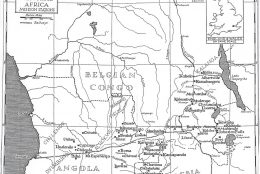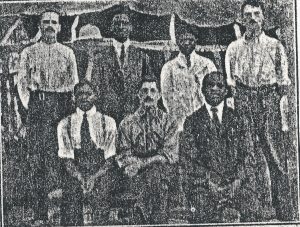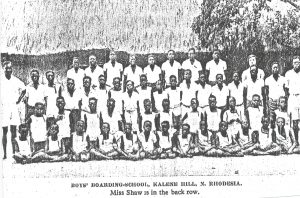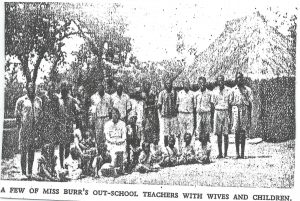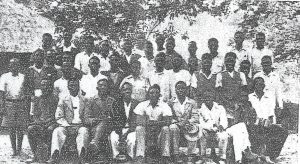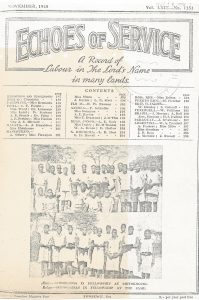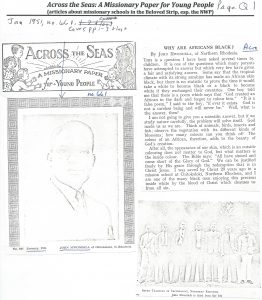Brethren Articles: 1907-1940s — NWP Brethren missions’ proverbial “little school in the bush”
This webpage contains dozen of articles from Brethren magazines in this period, as with the following page on South African General Mission (SAGM). Both pages contain key articles describing their new “little school(s) in the bush” and encouraged supporters to send help. (Both mission groups are described at great length in the e-book.) On both pages, pdf files of hundreds of journal articles can be opened through pull down menus and read online.
All are very old articles that were published in Echoes of Service from 1907 to the 1940s, followed by articles from various other lesser Brethren periodicals: Voices from the Vineyard, the Fields, Links of Help and Across the Seas (for children). The articles in Echoes start in 1907 when Dr. Walter Fisher opened Kalene Mission in Mwinilunga District. The little schools that were opened would slowly evolve into the NWP’s modern educational system. Besides the NWP, I have included many articles on the geographically adjacent parts of eastern Angola and southern Democratic Republic of Congo” (Congo DR), which together formed what the Brethren collectively called “The Beloved Strip” as shown on the rightmost map below. Both maps expand when clicked on.)
- Campbell’s Historical map
- F.S. Arnot, n.d.
- Beloved Strip & Forward Movement
Comments on the historical maps and F.S. Arnot. The Brethren’s assemblies most noted missionary was F.S. Arnot. He explored a large area of south central Africa that stretched across eastern and northern parts of Angola into Northern Rhodesia and the southern Congo. (The Brethren called this area “The Beloved Strip.”) Dugald Campbell also became extremely famous in the U.K. as another Brethren missionary. He lived most of his life in the southern Congo DR. The map on the left appears inside the front cover of his book Blazing Trails in Bantuland (London, Pickering & Inglis, 1933). As the map was created well, it may help researchers. The map on the right is taken from my dissertation and e-book and also covers “The Beloved Strip” plus the SAGM’s areas in Angola and the NWP.
During my research over 30 years ago, I made notes on all journals (periodicals) until Zambia’s Independence in 1964. Unfortunately in following years I destroyed all materials beyond the 1940s. Fortunately, I did not destroy my research notes and comments, which are now 40+ years old. Appropriate notes and comments are included at the end of each periodical’s articles that might assist at least a few young scholars doing research on the NWP and the origins of the modern educational system. (These materials were used when I wrote my dissertation, and are often referred to in my e-book.)
The following webpage, SAGM Articles: 1910-1940s, contains similar materials from several periodicals by the South African General Mission in the UK, South Africa and later the USA.
Some tips on using these old articles. All have been added to the website by the same method used on the webpage “Archive Transcripts” , i.e., when the user clicks on the label, the material pops up in a separate screen (window). As indicated, some years contain dozens of pages. A red divider separates each segment; generally just a year or two. To help the reader, the chronological pop up pages are numbered by numerals, e.g., A1, A2, B, C, etc.. For each group of articles, key geographical and place terms, plus the names of key people (“actors”) are given to help in searches. The pdf files from periodicals often contain extraneous research side notes, which helped me write my dissertation over three decades ago in the pre-computer days. Obviously the reader must ignore these.
Although these documents from periodicals are very old and hard to find, they cannot be considered truly “archival” as they were/are published material. I am also aware that many of the pictures look quite grainy and scruffy but I do not have better ones. The sources are given for any scholar who wants to replicate them in a more satisfactory manner.
David Wilkin
================================
Articles in Echoes of Service from 1907-1945:
- 1907-1913 — Echoes: 1907-1913, 14 pp. Geographical and place terms include: Kalene Hill, Kavungu, Kazombo, Chitokoloki, and Kansanshi. Actors include: F.S. Arnot, Dr. Walter Fisher, George Suckling, Higgins, and Mwondela.
- 1914 — Echoes: 1914, 27 pp. Geographical and place terms include: Kalene, Kavungu, Kazombo, Balovale, Chitokoloki, Kabompo, and Lungevungu. Actors include: F.S. Arnot’s death, Dr. Walter Fisher, George Suckling, T. Lambert Rogers, and Bailey of SAGM.
- 1915 — Echoes: 1915. 18 pp. Geographical and place terms include: Kalene, Balovale, Chitokoloki, Kabompo, Lungevungu, and Lwena River. Actors include: George Suckling, Rogers, Chief Shinde, Kalunda, Mwondela, Katolo Fisher, May Fisher, Dr. Walter Fisher, Singleton Fisher, and Charles Sawyer.
-
- 1915 front cover of Echoes and teacher’s home
- 1916 — Echoes: 1916, 17 pp. Geographical and place terms include: Kalene, Kabompo, Chitokoloki, and Arnot Memorial School. Actors include: George Suckling, Walter Fisher, Singleton Fisher, Thomas Hansen, T. Lambert Rogers, H. Julyan Hoyte. Story of F.S. Arnot’s death.
-
The picture above in Echoes, October 1916 is not very clear but the best I could locate. It is very important because the men in it were Suckling, other missionaries and earliest African workers. The caption was: “Believers in Fellowship at the Kabompo, N.Rhodesia” The text that followed said: “This was taken some months ago, Mr. Suckling on the left, Mr. Rogers (now with the Lord) on the right, while Mr. Hansen is seated. The four natives are helpers from the older Lovale and stations; at the back Mwondela and Ikasha, and in front Katangu and Chinyama. The two latter have been with Mr. Suckling from the beginning of the work at Kabompo.”
- 1917 — Echoes: 1917, 13 pp. Geographical and place terms include: Kabompo, Kalene, Chitokoloki, and Arnot Memorial School. Actors include: Dr. Walter Fisher, Thomas Chinyama, Thomas Hansen, H. Julyan Hoyte, Chief Ntambu, Singleton Fisher, May Fisher, and George Suckling.
- 1918 — Echoes: 1918, 16 pp. Geographical and place terms include: Kabompo, and Kalene. Actors include: Singleton Fisher, May Fisher, George Suckling, Sameta, Chief Ntambu, Katolo Fisher, Thomas Chinyama, and Thomas Hansen.
- 1919 — Echoes: 1919, 8 pp. Geographical and place terms include: Kavungu, Mwinilunga, Chitokoloki, Kabompo, and Kazombo. Actors include: George Suckling, Thomas Hansen, M. Kathleen Fisher, Bruce Miller, Thomas Chinyama, Thomas Hume, and Mwondela.
- 1920 — Echoes: 1920, 8 pp. Geographical and place terms include: Kalene, Kazombo, and Benguella Railway. Actors include: George Suckling, Dr. Walter Fisher, John Rodgers, Chilila, Ndumba, and Thomas Hansen.
- 1921 — Echoes: 1921, 7 pp. Geographical and place terms include: Kalene, Kazombo, Kavungu, and Chitokoloki. Actors include: Dr. Walter Fisher, Dr. Georgina Darling, Thomas Hansen, Stanley Coad, Digby Fisher, and Douglas Hume.
- 1922 — Echoes: 1922, 16 pp. Geographical and place terms include: Chitokoloki, Kalene. Actors include: George Suckling, Higgins, Elsie Burr, Murrain, Douglas Hume, Stanley Coad, Dr. Walter Fisher, Hettie Fisher, Wilfred Fisher, Singleton Fisher, Henry Faulkner, Chief Ntambu, Dr. Georgina Darling.
- 1923 — Echoes: 1923, 14 pp. Geographical and place terms include: Kalene, Kabompo, Kalunda, Kavungu, Kazombo, Chitokoloki, and Lungwebungu. Actors include: Mary Kathleen Fisher, Sydney Buckland, Digby Fisher, Stanley Coad, Henry Faulkner, Dr. Walter Fisher, George Suckling, and Walter Logan.
- 1924 — Echoes: 1924, 13 pp. Geographical and place terms include Kangwanda, Kabompo, Kalene, Chavuma, Kamapanda, Kalunda, and Sakeji. Actors include: Digby Fisher, Dr. Georgina Revington Fisher, Dr. Walter Fisher, Wallace Logan, Nigel Arnot, and Herbert Sims.
- 1925 and 1926 — Echoes: 1925-1926, 8 pp. Geographical and place terms include: Chitokoloki, Kalene, Chavuma, Kabompo, and Kangwanda. Actors include: Stanley Coad, Wallace Logan, Henry Faulkner, G. W. Mowat, Thomas Hansen, and Douglas Hume.
- 1927 and 1928 — Echoes: 1927-1928, 7 pp. Geographical and place terms include: Kangwanda, Chitokoloki, Kalene, and Chavuma. Actors include: George Suckling, Douglas Hume, Singleton Fisher, Thomas Hansen, Murrain, Sydney Buckland, and Wallace Logan.
- 1929 and 1930 — Echoes: 1929-1930, 7 pp. Geographical and place terms include: Chitokoloki, Kalene, Nyamboma, Kangwanda, and Kazombo. Actors include: Dr. Walter Fisher, Thomas Hansen, George Suckling, Elsie Burr, and Herbert Sims.
-
Afro-Caribbean and Afro-American Brethren assembly missionaries before 1930 in “The Beloved Strip.” When doing my research 30+ years ago, I was intrigued by photos and text from several families of missionaries of color, especially the Murrain family included in the photo below. As they served in Angola and the Congo, they did not come directly into my research area. From Echoes and other sources, I learned that a key assembly was in Brooklyn, NY, and it was possibly connected with assemblies in British Guyana. I informally discussed these missionaries with current missionaries who said the early families were not replaced as the color bar increased. Had I continued my academic research in my younger days, this was a topic that I hoped to explore further. Young researchers today should indeed explore this interesting story. The following photo in Echoes, August 1915 shows the Murrain family with other Brethren missionaries headed for “Portuguese West Africa.”
- Murrain family w/other Brethren missionaries
- 1931 and 1933 (none in 1932) — Echoes: 1931-1933, 6 pp. Geographical and place terms include: Kalene, Chavuma, and Chitokoloki. Actors include: Herbert Sims, Frederick Barnett, George Suckling, and James Caldwell.
- 1934 and 1935 — Echoes: 1934-1935, 9 pp. Geographical and place terms include: Chitokoloki, Chavuma, Lukunyi, Sakeji, and Nyamboma. Actors include: James Caldwell, George Suckling, Miss R. Shaw, Miss E. Burr, and Mwondela.
-
- Miss R. Shaw w/students
- Elsie Burr w/teachers
Under government encouragement / pressure, Kalene Hill mission starting developing it primary schools in the mid-1930s. The two pictures above from Echoes shows Miss R. Shaw (left) and Miss Elsie Burr (right) with students (left) and out-school teachers with wives and children (right).
- 1936 and 1937 — Echoes: 1936-1937, 11 pp. Geographical and place terms include: Kalene, Kakwata, Sakeji, Kamapanda, Chitokoloki, Mujimbeji, Chavuma, Nyamboma, and Balovale. Actors include: Singleton Fisher, Dr. Julian Hoyte, Miss E. Whyman, George Suckling, Miss A. Spong, Victor Reed, James Caldwell, Miss G. Motter, and Miss R. Banning.
- 1938 and 1939 — Echoes: 1938-1939, 19 pp. Geographical and place terms include: Chitokoloki, Chavuma, Kamapanda, Hillwood Farm, and Balovale. Actors include: George Suckling, Samungole, James Caldwell, E.H. Sims, Bertha Mullen, Victor Reed, Miss G. Motter, Dorothy Barnett, Thomas Hansen, G.W. Mowat, Dr. D. Kaye, and H. Deubler.
- 1940 and 1941 — Echoes: 1940-1941, 7 pp. Geographical and place terms include: Nyamboma, Chitokoloki, Kabulamema, Chavuma, and Balovale. Actors include: Thomas Hansen, H. Deubler, Elsie Burr, George Suckling, G. Butcher, Thomas Hansen, and James Caldwell.
The top picture below that was sent by George Suckling is of “teachers and out-school teachers attending a Bible-school at Chitokoloki.” The second picture is a cover page from Echoes with Chit’s school boys and school girls.
- Teachers & out-school teachers attending Bible school at Chit
- Echoes of Service, Nov. 1940, front cover
- 1942 and 1943 — Echoes: 1942-1943, 9 pp. Geographical and place terms include: Kalene, Chavuma, Chitokoloki, Kamapanda, Kakwata, and Kabulamema. Actors include: Wallace Logan, George Suckling, Singleton Fisher, James Caldwell, W.J. Bentley, Daisy Wareham, V.C. Reed, Sydney Buckland, Mwondela, Silas Chifwanyisa, and Miss R. Banning.
- 1944 and 1945 — Echoes: 1944-1945, 4 pp. Geographical and place terms include: Kalene, and Chitokoloki. Actors include: Miss R. Banning, Daisy Wareham, V.C. Reed, and H. Deubler.
Notes and Comments on Echoes from 1905-1945: These were mainly written in 1975 starting with Jan. 1905 (Vol. 34) and much of the rest of this paragraph is quoted or paraphrased. In the early volumes were many references to F.S. Arnot and also C. Swan as they were by that time very famous in the U.K. for their travels and missionary work in Brethren’s “The Beloved Strip.” Early in the period 1905-1915 what is extremely notable was the educational work (emphasis on) at Koni Hill (Katanga), the Angola stations (more settled in Bihe), and Luapula (Northern Rhodesia). This was in contrast to Kalene, which was founded firstly as a sanatorium for European workers as it was considered healthy. It was also near the Lunda and Luvale groups that Dr. Walter Fisher wanted to evangelize and was sort of geographically the middle of other regions of the Beloved Strip. Hence little mention of education here in contrast to Luapula. Possibly one of the reasons for the later lag of education in the NWP.
Articles from other Brethren periodicals
- Links of Help, 10 pp., 1915-1934. Geographical and place terms include: Kalene, Chitokoloki, Balovale and Kalunda. Key actors include: Dr. Walter Fisher, Walter Logan and Mr. Rudge. Angola government language requirements in schools.
Notes and Comments on Links of Help. Glasgow: Pickering and Inglis. Published from 1911 to 1935. In January 1936, it was incorporated into The Harvester that was in Bath (later London) by Paternoster Press from 1923. It was published for Brethren assemblies as a supplement for Echoes of Service for Misionary Study Classes (M.S.C.). It did not strive to reproduce “hot off the press” news from the mission field, but to digest it for M.S.C. groups and classes to arouse and maintain their interest in supporting missionaries by describing their challenges. Many issues were available at the British Museum.
- Across the Seas: A Missionary Paper for Young People, 1901-1951, 25 pp. Geographical and place terms include: Kalene, Chitokoloki, and Kabompo. Writers during this 50+ years included: Dr. Walter Fisher, Winifred Hoyte, F.S. Arnot, Daisy Gibson, Daisy Wareham, Charles Stokes, and John Mwondela.
Notes and Comments on Across the Seas: A Missionary Paper for Young People. Glasgow: Pickering and Inglis, 1901-52. It was founded by F.S. Arnot and under his care until 1908; thereafter, many references to his missionary work in Central Africa. As he was in southern Africa much of this time, probably he did not do much hands-on editing. An editor’s note in Dec. 1952 says that this was a last issue after “52 years because of high printing costs.” I used this magazine at the British Museum, probably in Jan. 1976 and the call number was: P.P. 913.h.l. It was divided into three bundles: (a) 1901-1918, (b) 1919-1933, and (c) 1934-1954 (?).
Mwondela family and Brethren Assemblies. I was fascinated by the following article and photo in 1951 in Across the Seas. Since the earlier days at Chitokoloki, the Mwondela family has been an important name. The original Mwondela (first name never given) was referred to many times by George Suckling and he appears in a 1907 photograph earlier on this page. Through ups and downs, his direct descendants are still involved in the assemblies. Two key lines of the families are John (below) and Willie. There is an audio-transcript of my interview with John on my Interview webpage.
- John Mwondela’s article in 1951
- Voices from the Vineyard, 16 pp., 1916-1938. Geographical and place terms include: Kalene, Kazombo, Kabompo, Kangwanda, and Chavuma. Writers over these yeas included: John Rodgers, Thomas H. Higgins, Thomas Hansen, May Fisher, E.H. Sims, George Suckling, G. R. Murrain, Elizabeth and Mary Murrain, Douglas Hume, and James Caldwell.
Other Notes and Comments about Voices from the Vineyard. Seems to have started in 1905 (New York) as the main USA and Canadian periodical that supplemented Echoes of Service. In 1938 The Fields also began publishing (see below) and they merged in 1971 to become Christian Missions in Many Lands (now Missions)
- The Fields, 8 pp., 1938-1943. Geographical and place terms mentioned included: Chavuma, Balovale, and Kabulamema. Frequent writers were: Wallace and Ruth Logan, and George Butcher.
Notes and Comments on The Fields. Published in Fort Dodge, Iowa: Walterick Printing Co., from 1938 to 1972. Along with the much older Voices from the Vineyard, it was one of the two main periodicals in the U.S.A. and Canada that merged in 1971 to become Christian Missions in Many Lands (now Missions).
Other Brethren periodicals for which I either took no notes and/or were not published before 1945. Many are still being published but I stopped checking and using them after the mid-1980s. Also, as noted elsewhere, I destroyed all my notes after 1945.
- Christian Missions in Many Lands (now Missions). As noted above, it began in 1971 with the combination of two American/Canadian journals: Spring Lake, New Jersey. It is now the key magazine for the Brethren assemblies.
- Echoes Quarterly Review. Bath, started in 1949. A quarterly review that gave in depth reports on Brethren missionaries around the world. Also contained reflective articles on up-dating Brethren missionary principles to accommodate needs in a post-colonial Non-Western world.
- Medical Missionary News. London: Paternoster Press, started in 1953. A quarterly journal that gave much attention to medical missionaries in south central Africa.
- Australian Missionary Tidings (later simply Tidings), Chatswood, N.S.W.
- From Other Lands: A Missionary Magazine for Young People. Bath, from 1956. . Seemingly a replacement for Across the Seas.
- Harvest Fields [Ireland], after 1961. Never of use to my research.
- Home and Foreign Missions [Scotland], after 1972. Never of use to my research.
- Workers Together, Auckland, New Zealand, after 1954. Never of use to my research.
==============================


